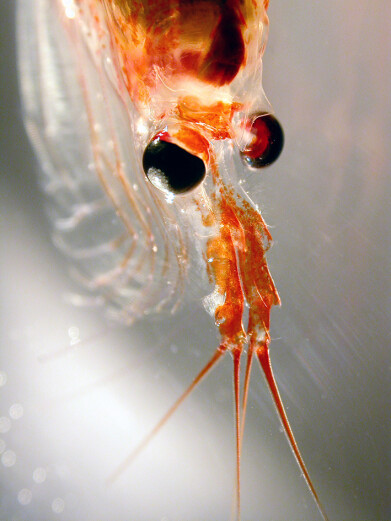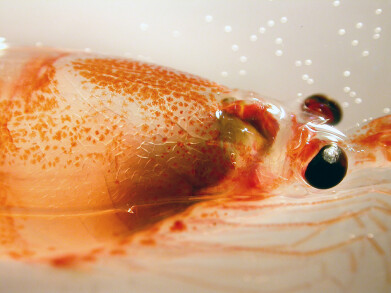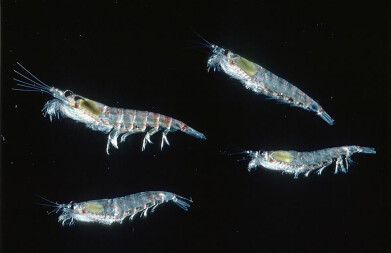-
 Close up of head of Antarctic krill Euphausia superba (British Antarctic Survey)
Close up of head of Antarctic krill Euphausia superba (British Antarctic Survey) -
 Single Antarctic krill Euphausia superba (British Antarctic Survey)
Single Antarctic krill Euphausia superba (British Antarctic Survey)
Water/Wastewater
Plastic pollution impairs antarctic krill's role in carbon sequestration
Nov 26 2024
New research reveals that rising levels of plastic pollution in the Southern Ocean could hinder the ability of Antarctic krill, small shrimp-like crustaceans, to assist in removing carbon dioxide from the atmosphere. Published this month in Marine Pollution Bulletin, the study highlights the impact of plastic particles on the krill’s role in carbon sequestration.
Antarctic krill feed on phytoplankton, microscopic plants that absorb carbon dioxide from the atmosphere. When krill excrete, their waste sinks to the deep ocean, carrying carbon with it and effectively sequestering it for long periods. However, researchers from the British Antarctic Survey (BAS) discovered that the presence of nanoplastics—plastic particles smaller than 100 times the width of a human hair—reduced the ability of krill faeces to lock away carbon by 27%.
Krill represent an enormous biomass, roughly equivalent to that of all humans on Earth, and are crucial to the ocean's ability to store "blue carbon" in the Southern Ocean. This process is essential for combating climate change, and understanding how human activities affect the carbon storage capabilities of the ocean is critical for shaping global climate action.
These krill form vast swarms, some more than a kilometre long, and their faeces create a carbon-rich "rain" that quickly sinks to the deep ocean. This process helps sequester carbon and reduces its presence in the atmosphere. In a recent study, researchers from Imperial College London and BAS estimated that krill faeces lock away at least 20 million tonnes of carbon annually, a figure comparable to that stored in vital "blue carbon" ecosystems like mangroves, saltmarshes, and seagrasses.
Clara Manno, the lead author and a marine ecologist at BAS, noted: “Krill are essential to the Southern Ocean food web and are a primary food source for penguins, seals, and whales. While we’ve previously found plastic pollution in Antarctic krill, this is the first time we've shown that plastic could reduce their ability to sequester carbon by more than a quarter. This is a significant finding, revealing how plastic pollution disrupts not only the ocean's ecosystem but also its crucial role in regulating the global carbon cycle.”
During their research, scientists collected live krill samples from the RRS James Clark Ross near the sub-Antarctic island of South Georgia. In laboratory experiments, they observed how nanoplastics affected krill waste. The presence of these tiny plastic particles seemed to promote bacterial breakdown of organic materials, causing krill faeces to decompose faster. This reduction in the faecal mass means less carbon is transported to the deep ocean.
Co-author Emily Rowlands, a marine ecologist at BAS, added: “Though nanoplastics are invisible to the naked eye, they have a significant environmental impact. It’s not just the krill being harmed—they’re also essential for mitigating climate change. This underscores the urgent need for global action on plastic pollution.”
The study is particularly relevant to Antarctica, where krill populations face multiple threats, including ocean warming, acidification, and the pressures from fisheries. Understanding how human disturbances affect the carbon storage capabilities of krill is crucial for the future of the Southern Ocean ecosystem.
This research was funded by the UKRI Future Leader Fellowship project, ‘CalcUlating the Strength of the Plastic pump In Counteracting the Deep Export of Oceanic Carbon’ (CUPIDO).
The full study, titled ‘Plastics Counteract the Ability of Antarctic Krill to Promote the Blue Carbon Pathway in the Deep Ocean,’ is published in Marine Pollution Bulletin and can be accessed here.
Events
May 11 2025 Vienna, Austria
May 18 2025 Algiers, Algeria
23rd International Water Management Exhibition
May 20 2025 Prague, Czech Republic
Singapore International Water Week Spotlight 2025
Jun 23 2025 Singapore
Jun 25 2025 Sao Paulo, Brasil
.jpg)



.jpg)
















